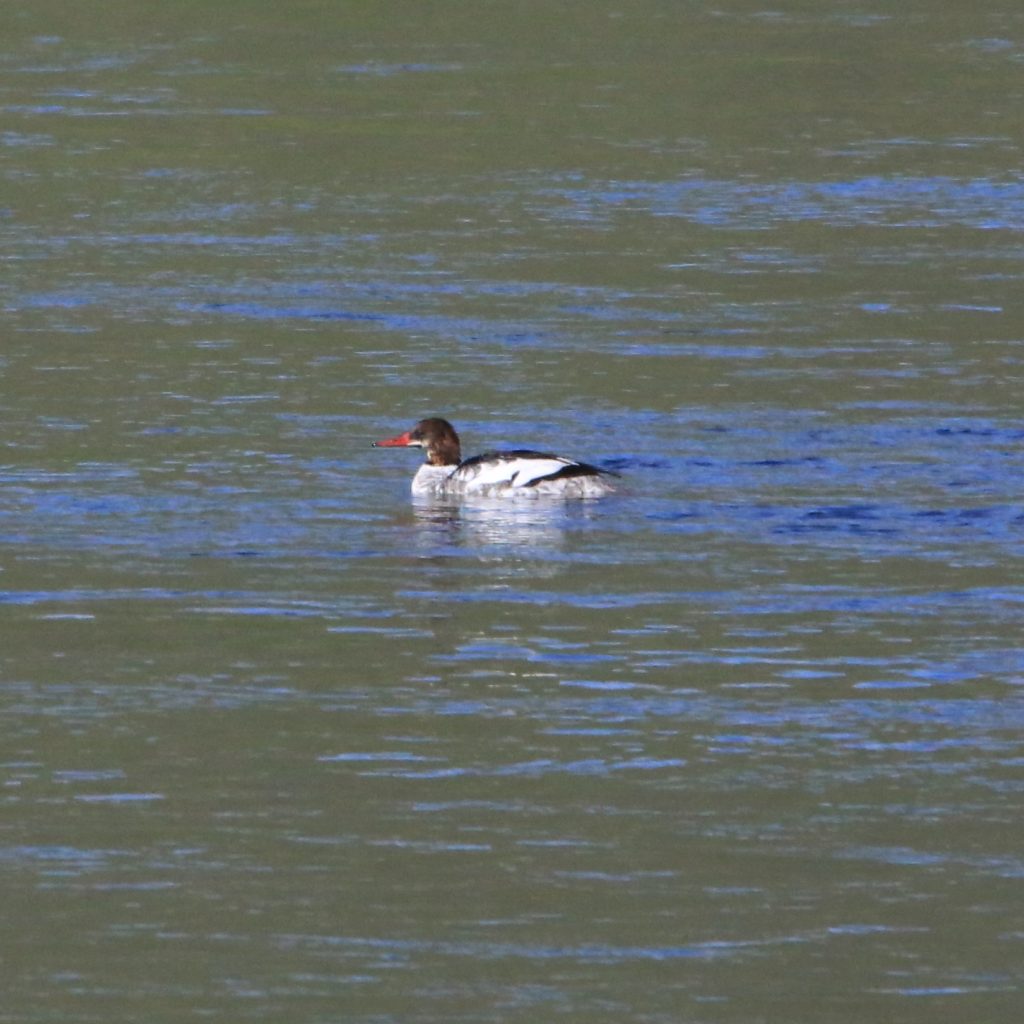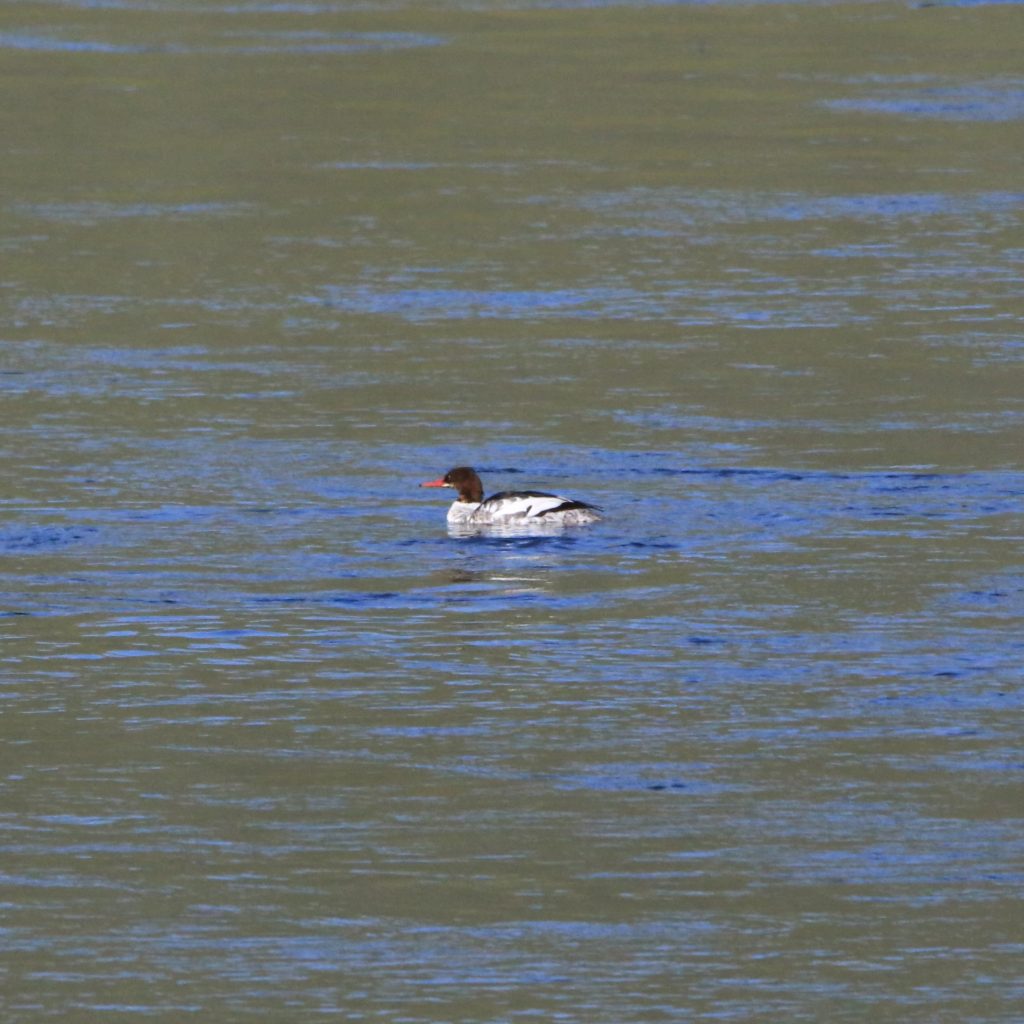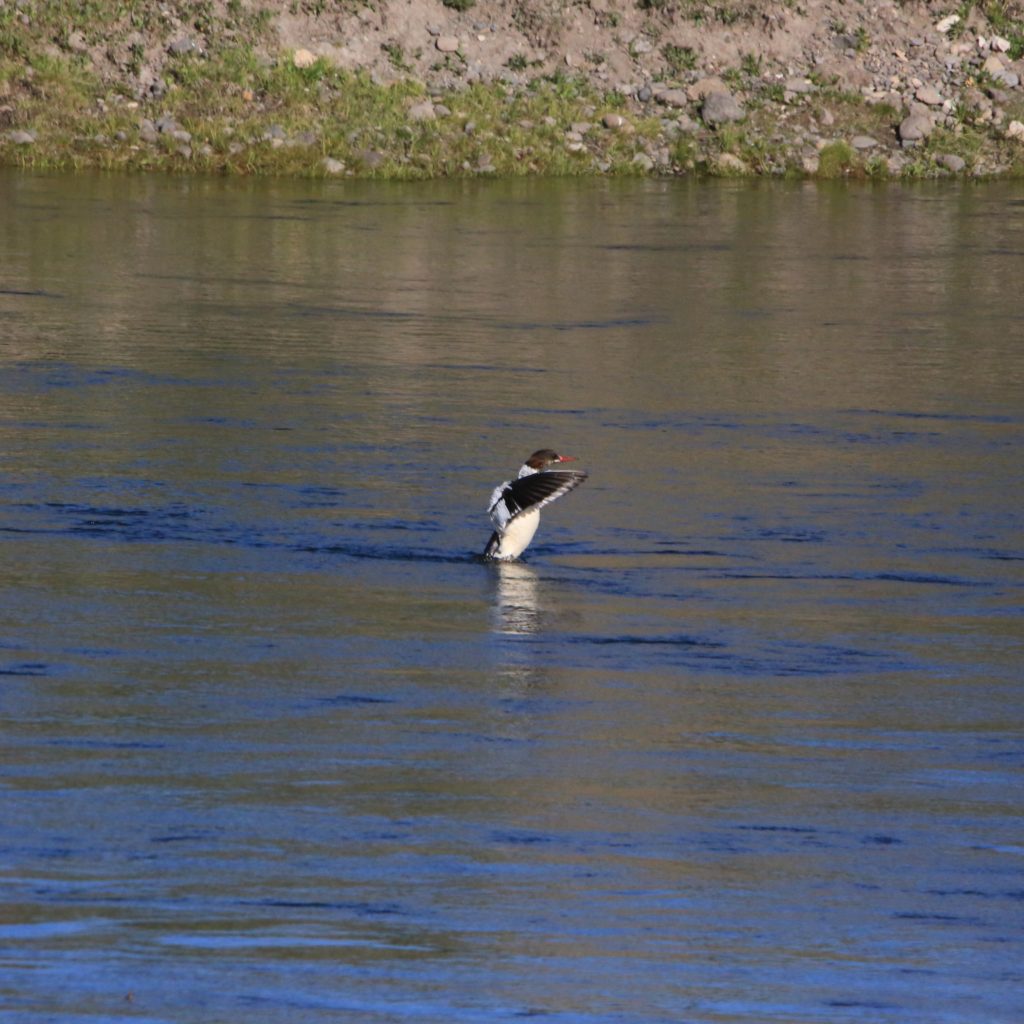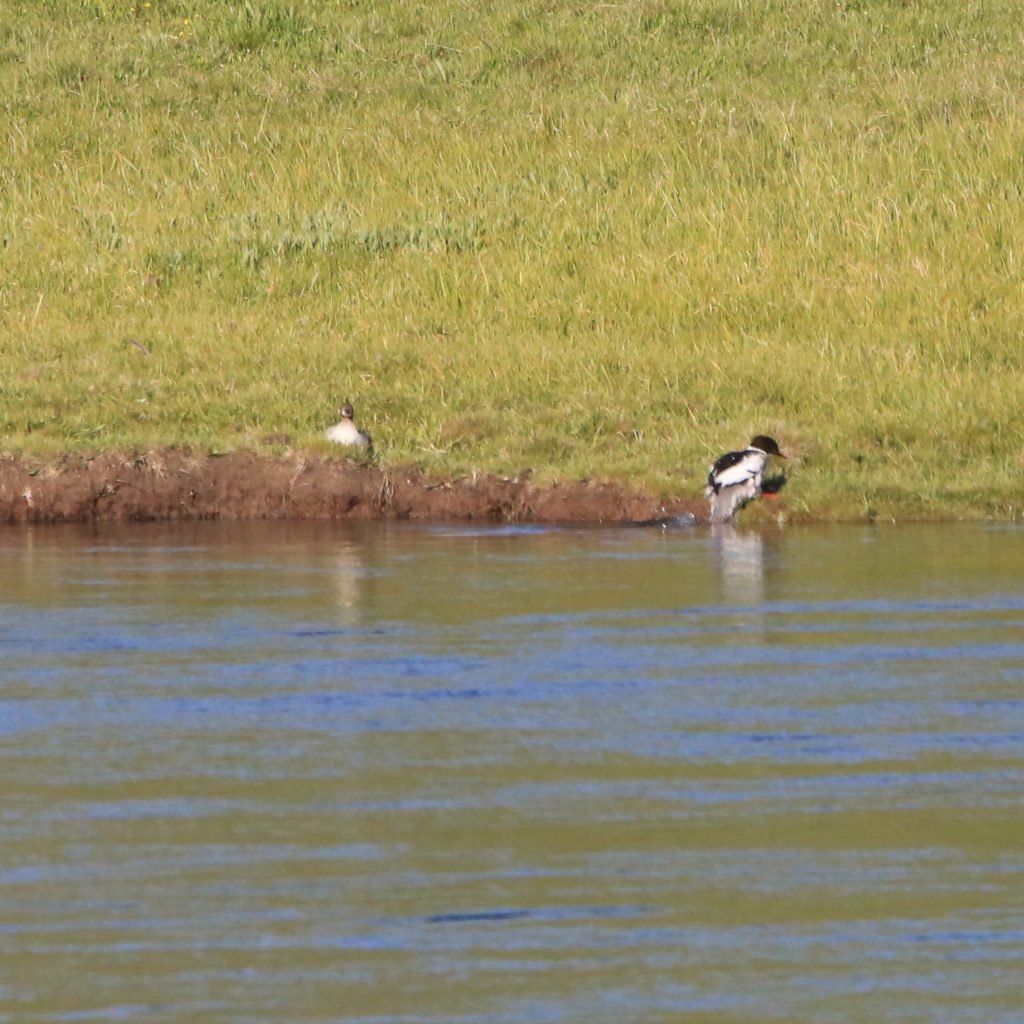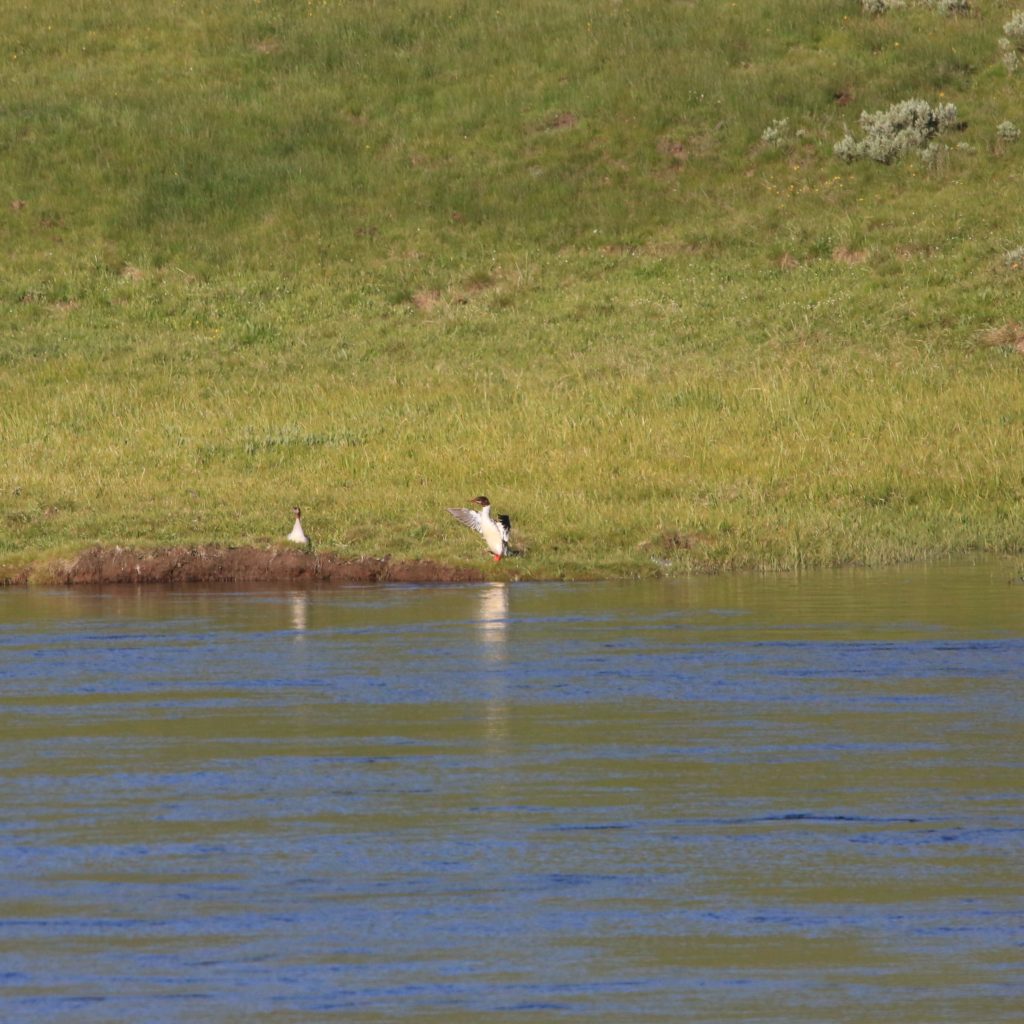
Common Merganser
A Common Merganser is a fun bird to see while bird watching. Below are some tips to help you identify Common Mergansers. We have also put together a list of fun Common Merganser t-shirts, Common Merganser bird patches, birdhouses, bird feeders, binoculars, stickers, and other fun bird watching items.
About Common Mergansers
The Common Merganser (Mergus Merganser) is a freshwater bird that feeds on fish. It is typically found in forested areas of Europe, North America, and Northern and Central Asia.
Description and Migration
Common Mergansers are the largest inland ducks in North America, and they are also the largest Mergansers. They display sexual dimorphism as the males are slightly larger than the females. Common Mergansers are 23-28 inches long, with a wingspan of 31-38 inches. Alike to other Mergansers, these birds have a crest of long head feathers that are smoothly rounded behind the head. During the breeding season, males can easily be distinguished by their white body which has a salmon-pink tinge, and a black head with a shimmering green gloss. The rest of their body is mostly black-and-white in coloration. The non-breeding plumage of these ducks is the same for both sexes. Younglings look similar to adult females.
Common Merganser Color Pattern
The adult male has an iridescent dark green head, a black back, and a very red bill. Its body is covered with gleaming white plumage. The female, on the other hand, is gray bodied white a cinnamon rusty red head and white chest.
Common Merganser Size
The Common Merganser is a long-bodied duck that has a straight narrow bill unlike the typical wide bill of most ducks. It is long-bodied with pointed wings that are rather thin.
The relative size for both sexes is:
- Length: 21.3-27.9 in (54-71 cm)
- Weight: 31.8-76.2 oz (900-2160 g)
- Wingspan: 33.9 in (86 cm)
Common Merganser Behavior
- The Common Merganser is a very good diver and swimmer; however, it has an awkward landing.
- When it is planning to take flight, it runs across the water in order to attain enough speed.
Common Merganser Food
Common Mergansers mostly eat fish. Other sources of nutrition for them are crustaceans, insets,
small mammals, birds, plants, and frogs. These ducks have serrated edges on their bills which
help them easily grip their prey. Common Mergansers forage in clear aquatic habitats which are
mostly less than 13 feet deep. In winters they might forage in habitats that are deeper where fish
travel in schools. These ducks can use their thin bills to probe sediments and underwater stones to
locate food. In winter, these ducks mostly eat fish such as suckers, sculpin, salmon, trout, sunfish,
chub, and sticklebacks. During the breeding season, they add mayflies, flies, water striders,
dragonflies, beetles, caterpillars, spiders, mussels, and snails to their diet. Younglings only eat
aquatic invertebrates for the first 12 days.
These ducks prey on small fish like eels, trout, and salmon. The edges of their bills are serrated and act like saw-like teeth. This helps them get a good grip of their prey even as they try to wiggle.
Common Merganser Habitat
Common Mergansers breed in large lakes and rivers next to boreal forests. These ducks need to
be close to trees as they build their nests in tree cavities. Common Mergansers winter in Coastal
regions south of their breeding range. Although these ducks prefer freshwater habitats during
winter, they have been observed wintering in estuaries, harbors, and coastal bays.
During their breeding season, they dwell in wooded lakes and rivers. Over the winter, they tend to take refuge in bays, rivers, and estuaries.
Range and Migration
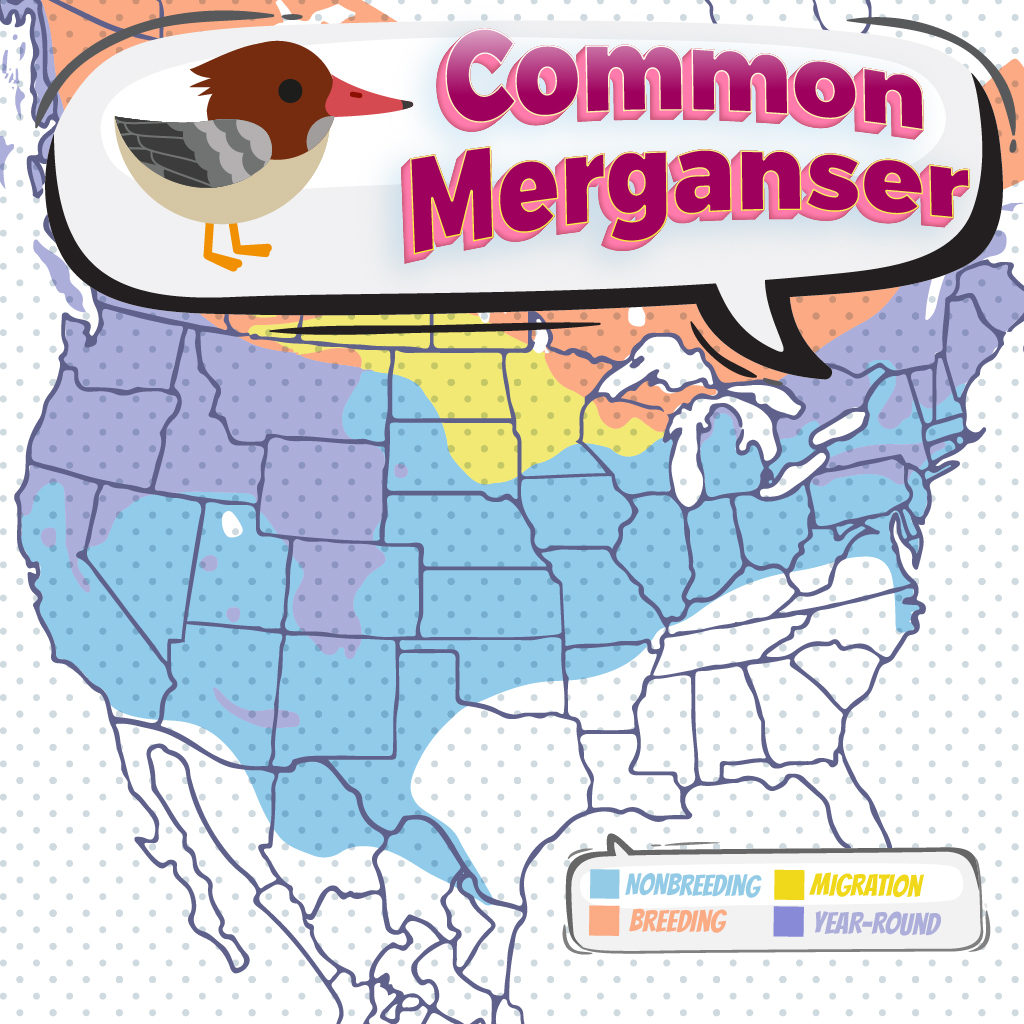
Common Mergansers are large, streamlined seaducks that are commonly found in the Nearctic
and Palearctic regions. These ducks are slowly losing their numbers in North America, but they are
still the most commonly found mergansers in the region. The breeding range of Common
Mergansers are observed to extend as far north as Canada and Southern Alaska. While some of
these birds are non-migratory, the others winter in Canada, America, New England, and the Pacific
coast of Canada and America.
Common Merganser Life Cycle
In late winter and early spring, both the male and female form pairs and get ready for the breeding season. The female lays bout 6-12 white to yellowish eggs either in nooks found in trees or in Woodpeckers’ nests. The female will then proceed to incubate her eggs for 28-35 days. After just two days, the duckling leaves the nest and dabbles in the water while looking for insects to feed on.
Common Merganser Nesting
Pairs of Common Mergansers are known to last at least for one mating season. Males court the
females by circling them with erect head feathers and their necks stretched forward. Females
choose the nest site which is about 100 feet above the ground in a natural tree cavity. In the
absence of tree cavities, Common Mergansers sometimes also nest in chimneys, rock crevices,
lighthouses, hollow logs, and burrows. On rare occasions, they have also been observed nesting on
the ground. Their nests are constructed solely by the females by using materials already present in
the nest cavity, and grasses. Females lay about 6-17 eggs, which are incubated for a period of 28-
35 days.
Ornithology
Bird Watching Academy & Camp Subscription Boxes
At Bird Watching Academy & Camp we help kids, youth, and adults get excited and involved in bird watching. We have several monthly subscription boxes that you can subscribe to. Our monthly subscription boxes help kids, youth, and adults learn about birds, bird watching, and bird conservation.
Bird Watching Binoculars for Identifying Common Mergansers
The most common types of bird watching binoculars for viewing Common Mergansers are 8×21 binoculars and 10×42 binoculars. Bird Watching Academy & Camp sells really nice 8×21 binoculars and 10×42 binoculars. You can view and purchase them here.
Common Merganser T-shirts
If you love the Common Merganser you should purchase a Bird Watching Academy & Camp T-shirt. To help support bird conservation we donate 10 percent to bird conservation activities.
Common Merganser Iron On Patches
Kids, Youth, and Adults love to collect our Bird Watching Academy & Camp iron-on patches. Our bird-watching patches help you keep track of the birds you have seen and identified. You can also display the patches on our Bird Watching Academy & Camp banners.
The Common Merganser is a great iron-on patch to start your collection with. The patches are durable and can be sewn on or ironed on to just about anything.
Common Merganser Stickers
Stickers are a great way for you to display your love for bird watching and the Common Merganser. We sell a monthly subscription sticker pack. The sticker packs have 12 bird stickers. These sticker packs will help your kids learn new birds every month.
Bird Feeders for Common Mergansers
There are many types of bird feeders. Here are our favorite bird feeders for your backyard. We use all of these bird feeders currently. Kids will have a great time watching birds eat at these bird feeders. Using this collection of bird feeders will provide a wide variety and many types of birds.
Best Bird Houses for Common Mergansers
There are many types of birdhouses. Building a birdhouse is always fun but can be frustrating. These 4 birdhouses have become our favorites. Getting a birdhouse for kids to watch birds grow is always fun. We spent a little extra money on these birdhouses but they have been worth the higher price and look great.


